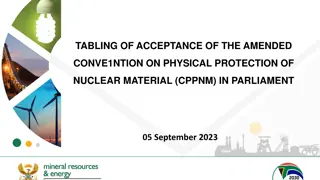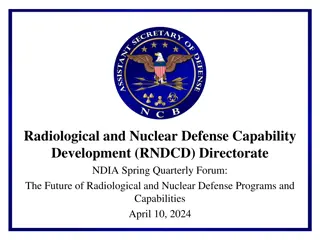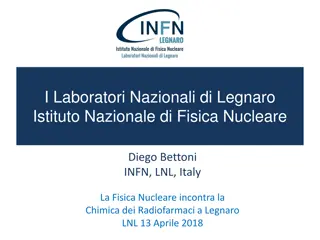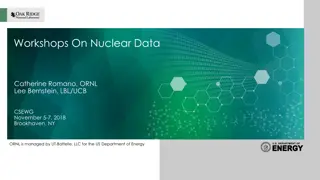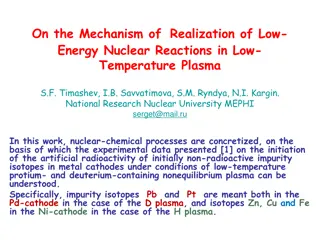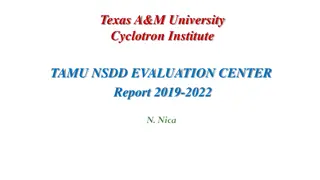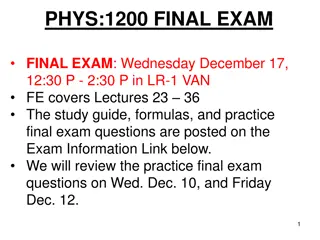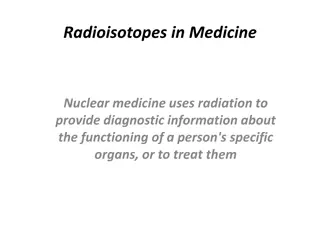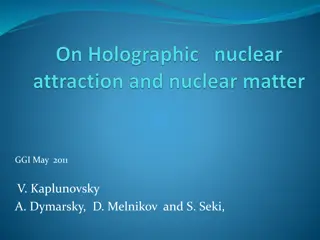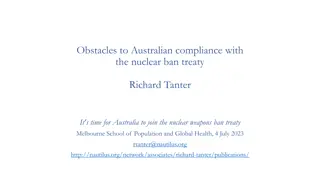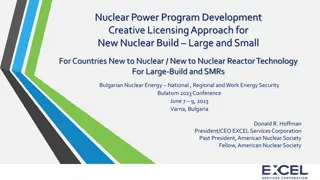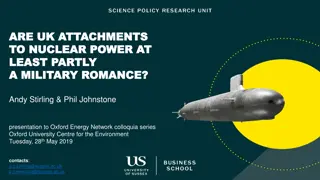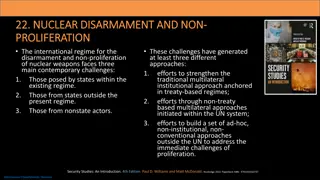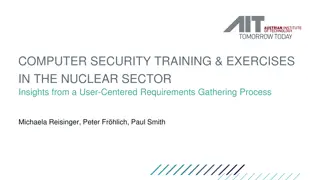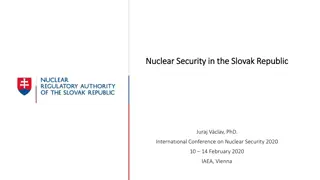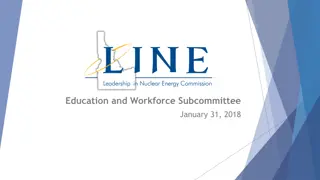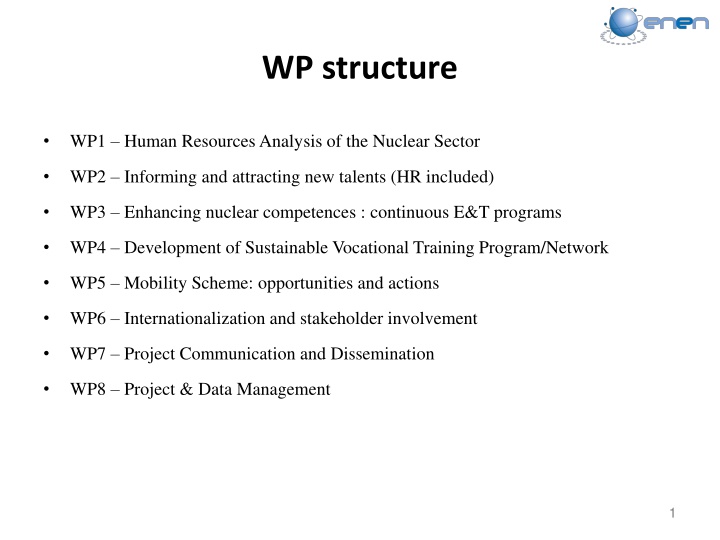
Enhancing Nuclear Sector Human Resources Analysis
This project focuses on reinforcing human resources in the nuclear sector, informing and attracting new talents, enhancing nuclear competences through continuous training programs, developing sustainable vocational training programs/network, implementing a mobility scheme, internationalization, stakeholder involvement, project communication and dissemination, as well as project and data management.
Download Presentation

Please find below an Image/Link to download the presentation.
The content on the website is provided AS IS for your information and personal use only. It may not be sold, licensed, or shared on other websites without obtaining consent from the author. If you encounter any issues during the download, it is possible that the publisher has removed the file from their server.
You are allowed to download the files provided on this website for personal or commercial use, subject to the condition that they are used lawfully. All files are the property of their respective owners.
The content on the website is provided AS IS for your information and personal use only. It may not be sold, licensed, or shared on other websites without obtaining consent from the author.
E N D
Presentation Transcript
WP structure WP1 Human Resources Analysis of the Nuclear Sector WP2 Informing and attracting new talents (HR included) WP3 Enhancing nuclear competences : continuous E&T programs WP4 Development of Sustainable Vocational Training Program/Network WP5 Mobility Scheme: opportunities and actions WP6 Internationalization and stakeholder involvement WP7 Project Communication and Dissemination WP8 Project & Data Management 1
WP1 Reinforcing Human Resources in the nuclear sector T1.1: HR needs of the European nuclear industry Use existing HR from past EU programs and organisations (JRC, ENEN) Collect information about HR needs of nuclear industry in Europe T1.2: HR needs of research centres, waste management and safety operators Collect information about HR needs in institutional agencies and research organisations T1.3: HR needs in non-power applications HR needs in medical applications of nuclear HR needs in other sectors (environmental, agriculture & food, inspection, space, etc.) T1.4: Academic offer in Europe Review of academic nuclear programs in EU universities and engineering schools T1.5: Analyze gaps, identify critical resources Identify skills, analyze gaps and critical resources for new nuclear build Identify skills, analyze gaps and critical resources for safety, dismantling, waste and back-end T1.6: EU strategy for E&T in nuclear Recommendations for maintaining, reinforcing or building new programs in EU Provide outputs for other WPs
WP2 - Informing and attracting new talents (WP lead: SCK CEN) This WP contributes to informing and attracting new talents, and increasing the number of nuclear careers, through: the development of one single point of entry for information on nuclear education, training, job opportunities, and access to facilities related to nuclear technology, radiation protection, waste, disposal and decommissioning, medical applications, fusion, space applications, integration of social sciences and humanities in nuclear, and other domains; the organisation of career events where information on education, training and careers in nuclear is given and opportunities for networking between students, young professionals and employers are created; increasing the visibility of outstanding work related to nuclear research or applications outreach towards pupils and their teachers with dedicated competitions and summer schools promoting transdisciplinary approaches as stimulating transdisciplinary collaboration in nuclear can be beneficial to create awareness on the broad applications of ionising radiation in nuclear as well as non-nuclear industry and healthcare.
WP2 Tasks Task 2.1 Promote existing E&T programmes (ENEN, SCK CEN, NN, NN, ) Development of a single point of entry HUB : existing courses, internships, thesis work, jobs and other opportunities + quality evaluation (WP3) in nuclear industry, healthcare, research and governmental institutions target students (secondary schools/BSc/MSc/PhD level) as well as nuclear professionals and teachers link to existing databases, WP5, access to infrastructures Task 2.2 Organize career events (SCK CEN, ENEN, BME, ENS, Foratom, i2EN, NN, NN) Promote CPD and careers, 4 (?) career events in different European cities (+hybrid organization) Task 2.3 Award outstanding work in nuclear (SCK CEN, ENEN, BME, ENS, NN) Increase visibility of outstanding nuclear research and achievements in Europe in different disciplines an annual event will be set up to award these successes. Task 2.4 Outreach towards pupils and teachers (BME, SCK CEN, NN, NN, NN) Attract to nuclear sector = start at young age; refer to actions of ENEN+ Task 2.5 Promote transdisciplinary approaches (SCK CEN, ULorraine, NN, NN) Stimulating transdisciplinary collaboration in nuclear can be beneficial to create awareness on the broad applications of ionizing radiation in nuclear as well as non-nuclear industry and healthcare organize 4 (?) Scientific Dating workshops.
WP3 Enhancing nuclear competences: continuous E&T programmes (BME) (SCKCEN, UL, CIRTEN, IJS, ENEN, ENS, JRS, EFOMP, FuseNet .) T3.1: Analysing and qualifying existing E&T programmes (SCK CEN) Collection and analysis of existing courses through the HUB (WP2) Review the existing courses according the CQAF and EQF for VET offers T3.2 E&T for new applications and innovation (CIRTEN) To complement the work of T3.1 with new themes according to needs expressed in WP1 and based on changing nuclear application landscape (ex. new technologies in nuclear energy, radiation protection medical application, space, decommissioning ) T3.3 Access to infrastructures (IJS) A collection and analysis of previous works listing different relevant infrastructures and their access modalities Universities, research centres, nuclear laboratories, training reactors, radiotherapy and nuclear medicine centres, special database for the secondary school excursion T3.4 Organising events for BSc/MSc/PhD students (BME) Summer schools, webinars, different competitions, technical visits, workshops for BSc/MSc/PhD students in a strong cooperation with the WP2, T2.3 T3.5 Setting up networking cross-YG and cross-professional organisations (ENS) ENS YG, IRPA YG, EFOMP YG, MELODI-YG, FuseNet-YG etc. 5
WP4 Development of Sustainable Vocational Training Program/Network T4.1: Identify and analyze the existing VET offer in the nuclear field Using existing analysis from the past Categorization of the VET offers Fragmentation, barriers T4.2: Creation and operation of a Nuclear VET Learning Community Extension on the basis of the existing ANNETTE learning community T4.3: Gap analysis, requirements specification Input from WP1 on required jobs and competences, potentially insufficient covered by current E&T Identification of critical jobs and VET that could cover / support these cr. jobs Needs to reinforce VET offer for critical jobs T4.4: Development of a European Platform centralizing and disseminating VET offers, and establishing common EU criteria to label VET offers Develop the specification of the platform (while checking possible synergies with WP2) Platform to be filled based on identified courses in 4.1 Develop common EU labeling criteria based on CQAF and EQF for VET offers T4.5: Implementation of the European VET Platform through first VET cases From 4.3 select identified areas with shortage of VET offers where a development of associated VET will maximize their impact Extend existing VET courses through e-learning or hybrid method of delivery Support extension of VET courses for hands-on training T4.6: Evaluation of the first VET cases and of running the European Platform Evaluation of the VET courses developed in 4.5 (one hands-on, one e-learning) Evaluation of the Platform, e.g., the sustainability, easiness to operate, feedback from users, automatization of processes 6
WP5 Mobility Schemes for Nuclear Talents T5.1 Develop a comprehensive mobility scheme Support nuclear careers (attract, develop, retain talents) From high school pupils/teachers to M.Sc, Ph D & postdocs complementary to Marie Curie All nuclear topics Cross-border, cross-sectoral, cross-stakeholder mobility Individual applications (individual work plans) Group applications (HE projects, international exchange [reciprocity], e.g. .ru, .jp, .us ) T5.2 Implement and manage the mobility scheme Managed by Mobility committee Mobility manual, web based application/evaluation systems Organize reviews Analyze/revise the system every 12 months. Reports. Part of the budget reserved to support revisions T5.3 Facilitate access to infrastructures Develop strong link with project NRT12 (NuclEngn). Other fields? Synchronize applications for mobility and use of (research) infrastructures Visits for high school pupils/teachers and BSc students T5.4 Identify and follow-up opportunities for sustainable funding Involve end-users and stakeholders Sustain and further develop the mobility scheme beyond the project 7
WP6 - Objectives and Tasks Objective: Theobjective of WP6 is to engage international organizations with the scope to provide the necessary set of Educational and Training actions to nuclear domains that are missing the expertise at the level of EU. Task 6.1 Assessment of gaps and identification of suppliers (ENEN, OECD-NEA-tbc; IAEA, EC-JRC, ETSON-tbc, ) Task 6.2 ENEN-RU cooperation in building nuclear competences (RU, ENEN, ) Task 6.3 ENEN-US cooperation in building nuclear competences (NEDHO, ENEN, ) Task 6.4 ENEN-JP cooperation in building nuclear competences (Tokyo, Fukui, Kyoto, ENEN, ) Task 6.5 ENEN-International organizations cooperation in building nuclear competences (IAEA, EC-JRC, UNENE, ENEN, ) 8
WP 6 Internationalization and stakeholder involvement Task 6.1 Assessment of gaps and identification of suppliers (ENEN, OECD-NEA, IAEA, EC- JRC, ETSON) At the level of EU several competences cannot be addressed due to lack of specialists of proper infrastructure. In the same time some countries or regions are more advanced in specific topics than those that can be found at the level of the European Union region 9
WP6 Internationalization and stakeholder involvement Task 6.2 EU-RU cooperation in building nuclear competences (based on former collaborations: ENEN-RU 1&2) Competence building for advanced nuclear reactor technologies: a. Competence mapping to identify industry needs and gaps in E&T domain. The Russian side would share its tools and experience for competence mapping in nuclear field. It would be applicable for both universities and industry/research institutes. b. Joint research actions for PhD level on assessment of national and multinational energy systems (introduction of Gen-IV reactors, SMRs, renewables, closed NFC). The focus of the analyses would be on meeting EU and Global challenges with combination of various advanced technologies. The actions would utilize the most advanced tools developed by international organizations, like MESSAGE from INPRO IAEA. c. E&T actions towards competence building and familiarization with the latest advancements in the field advanced nuclear reactor technologies. These actions would offer to students, nuclear research and industry a broader basis of highly qualified human resources and foster cooperation in nuclear power development. The actions would include mobility of students, professors, specialists through training courses, schools, seminars organized by both sides, ENEN and Russia. 10
WP 6 Internationalization and stakeholder involvement Task 6.3 ENEN-US cooperation in building nuclear competences (NEDHO, ENEN) Nuclear Engineering Department Heads Organization (US) - a new collaboration 11
WP 6 Internationalization and stakeholder involvement Task 6.4 ENEN-JP cooperation in building nuclear competences (based on previous experiences in EUJEP 1&2 projects) Terms are currently under definition: - Dedicated programs for Master , PhD and researchers - Focus on new research capabilities offered by JP labs and organizations - Tokyo, Fukui, Kyoto 12
WP 6 Internationalization and stakeholder involvement Task 6.5 ENEN-International organizations cooperation in building nuclear competences (IAEA, EC-JRC, UNENE, ENEN) In order to address various gaps in competences when it comes to nuclear energy, the International Atomic Energy Agency (IAEA) developed a series of Nuclear Energy Management schools jointly with local/national parties. The schools are addressing key issues and are implemented in various areas based on a need analysis. Considering that multiple countries from EU such as Romania, France, Finland, Slovakia, Poland, Bulgaria, etc. are looking at construction of new units, specific needs in training possible future personnel have been identified. This action will implement, annually, a two-weeks European regional Nuclear Energy Management school with specialized education and training based on found needs. The school will be implemented with the support from the IAEA and the EC-JRC. 13
WP7 Project Communication and Dissemination The objectives of WP7 are: To disseminate the project results to targeted audiences and general public To assure communication with relevant stakeholders and decision makers To support outreach to potential beneficiaries. T7.1. Design of promo material and set-up a dissemination and communication plan (EVALION + ENEN) Creation of the Project identity package : Logo, Project poster, project flyer, PPT Template (M6) + Compilation of communication & dissemination plan (M12) T7.2 Dissemination and Communication of project results (ENEN + All partners) Website (M6) + webpage under ENEN website (M3) + specific actions to promote programs. (With feedback survey for measurable impact) T7.3 Increasing outreach of project activities (ENEN + All partners) Networking events (ENEN PhD event / EMSNE event for MSc, NESTet Conference) + participation to international conferences + promotion on website & socials (continuous action) IN GENERAL: All project partners are kindly invited to contribute in communicating and disseminating the project outputs by sharing the info about project outcomes within their network and acting as resonators for the nuclear community 14

